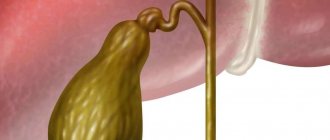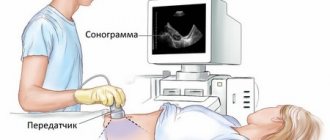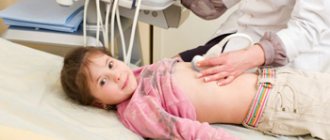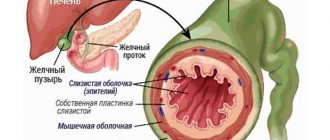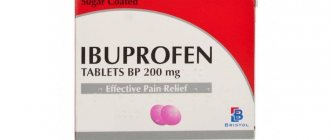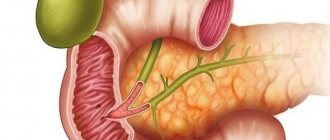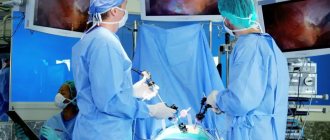Concept of deformation
To understand what deformation of the gallbladder (gallbladder) is, you need to have an idea of the structure of the organ and its functionality. Outwardly, it looks like a bag or a pear, the size of which increases with age. In a newborn child, the length and width of the gallbladder are about 40*10 mm, and in an adult (on average) – 90*25 mm.
The organ consists of three main parts:
- bottom;
- body;
- neck.
The cervix opens into the cystic duct, which connects to the hepatic duct. Deformation of an organ can occur in different parts of the organ; the type of pathology, its symptoms and possible complications depend on this.
There are two types of deformation of the gallbladder:
- congenital - disturbances in the shape and structure of the organ occur in the embryo when it is inside the womb; pathology is usually diagnosed during the first year of life;
- acquired - diffuse changes occur in an adult and are provoked by various factors, including an unhealthy lifestyle.
Congenital pathology is rare; more often the disease occurs over the years. The risk group includes older people over 50 years of age. Many people do not suspect for years that the gallbladder is deformed; they find out about it only when obvious symptoms appear and their health deteriorates.
FACT. According to statistics, various types of deformation occur in more than 30% of people around the world, so the pathology deserves attention.
Contour and other types of deformation
A deformed gallbladder can look different, it all depends on what type of pathology has developed. There are three main varieties:
- curvatures or kinks;
- wall compaction;
- contour changes.
If the gallbladder is bent, that is, bends or kinks appear, this means that the first type of pathology has developed. It can be functional or labile. Functional deformation appears when there is a change in posture, sudden movement, heavy lifting, or other physical activity. Labile deformity appears only after excessive tension of the abdominal muscles or after stress.
Functional deformation is usually easily eliminated by performing certain exercises.
Most often, there is an inflection in the body of the gallbladder or between the body and the bottom. There is also a complicated form of organ curvature - multiple bends, in which several bends occur. An s-shaped deformity is common.
The next type of pathology – hardening of the walls – is less common. Normally, the walls of the bladder do not exceed 5 mm in thickness; if this figure is exceeded, problems arise. There are no special signs that arise when an organ hardens; usually this type of deformation is diagnosed by chance when viewed on an ultrasound.
The last type - contour deformation of the gallbladder means a change in its shape. Depending on where the changes occur, the bubble begins to resemble an hourglass, an arc, or a pear. With this pathology, constant acute pain quickly develops. Due to a violation of the integrity of the walls, bile can enter the stomach cavity, causing severe complications in the digestive system.
Symptoms and signs
Deformation of the bladder, when it is bent in the neck or body, may be asymptomatic, but often a person periodically experiences symptoms associated with obstruction of the bile ducts:
- increasing pain in the hypochondrium on the right;
- difficulties during bowel movements (constipation, irregular or too frequent bowel movements);
- increase in temperature;
- nausea to vomiting;
- weakness, dizziness;
- bitter, nauseating taste in the mouth;
- lack of appetite;
- flatulence.
The stool becomes light or completely discolored. Jaundice is sometimes observed, especially noticeable in the eye sclera. A thick yellowish coating appears on the tongue, which is difficult to remove with a toothbrush.
The latent form of bladder disease is almost always accompanied by steatorrhea. Droplets of undissolved fat and bile secretion can be seen in the stool. Feces change due to disturbances in the digestive process, which are provoked by stagnation of bile secretion.
Causes
Pathology can be provoked by several factors; often several of them become the cause of changes in the gallbladder.
Congestive gallbladder
The acquired form of the disease can occur due to conditions such as:
- chronic cholecystitis (inflammation of the gallbladder) - as a complication in the absence of proper treatment;
- cholelithiasis;
- other bladder diseases associated with bile stagnation;
- diseases of the gastrointestinal tract, including chronic ones;
- past acute infectious diseases;
- neoplasms in the abdominal organs;
- parasitic diseases.
Some reasons that can provoke pathology are associated with a person’s incorrect lifestyle and bad habits. These include:
- alcohol abuse;
- smoking;
- poor nutrition;
- improper exercise;
- lifting weights;
- frequent stress.
Poor nutrition, which can provoke gallbladder pathologies, can be associated with the consumption of junk food, lack of a regular diet, or frequent overeating or fasting.
The causes of congenital deformity are associated with intrauterine developmental disorders of the embryo. This can be caused by both a genetic factor and errors in nutrition and other habits of the expectant mother during pregnancy.
There are also congenital abnormal phenomena in which deformation of the organ is observed: absence of the gallbladder, presence of a second organ, doubling of lobes, etc.
What is gallbladder deformation and how does it happen?
Deformation is a condition in which the size changes, the shape or composition of the bladder tissue is distorted. There are several types of gall bladder deformation:
- S-shaped gallbladder - the organ bends and becomes like a hook, taking on the shape of the letter S. It is often congenital in nature and can worsen with age.
- Multiple irregularities in shape (defects appear in several places) are one of the most severe types of pathology, occurring with severe pain, inflammation, and swelling of soft tissues.
- Cervical deformity is a pathology typical for people with advanced chronic cholecystitis.
- Violation of the structure of the bladder body alone is an asymptomatic pathology that rarely leads to complications. It can occur with poor diet and lead to digestive disorders.
- Deformation after physical overexertion and sudden movements is a temporary disorder that is not considered a pathology.
- Contour deformity is a violation of the outline, which can be caused by chronic inflammation or impaired bile outflow. It manifests itself as acute pain immediately after eating fatty or heavy food.
- Absence/doubling of the bladder is an extremely rare condition. In the first option it can be congenital or acquired, in the second – only congenital.
- Diverticulosis - single or multiple protrusions on the walls.
The first option occurs due to disruptions in the development of the embryo. The following can provoke an acquired form of biliary distortion:
- calculous cholecystitis;
- Botkin's disease;
- inflammation of the liver with any hepatitis;
- adhesions in the peritoneum;
- displacement of other organs;
- insufficient tone of the diaphragm;
- abdominal hernia;
- poor quality nutrition, bad habits, especially alcohol addiction;
- operations, oncology in the peritoneal area;
- parasitic infections.
Changes in position, curvature of the bladder and cholestasis are often observed in expectant mothers during pregnancy, when the growing child begins to displace organs, including the gall bladder. A similar problem occurs in obese people. Their gall bladder is displaced under the weight of fatty tissue, which causes a serious disturbance in their well-being.
Symptoms
The first time after the onset of the pathology, its symptoms may be completely absent. If any problems appear, it is difficult to recognize them as gallbladder disease. Over time, moderate symptoms appear and as the deformity develops, they become more pronounced.
Sometimes a pathology may not make itself felt for years, so some people find out about it by chance, for example, during a routine ultrasound of internal organs.
Among the most pronounced symptoms, the most common are:
- problems with bowel movements, frequent constipation or diarrhea;
- nausea, vomiting;
- loss of appetite, sudden weight loss;
- increased body temperature;
- heartburn, bitter taste in the mouth;
- painful sensations in the area of the right hypochondrium;
- deterioration of general condition.
Where does it hurt?
The pain that occurs when the gallbladder is deformed is extremely similar to that that accompanies coronary heart disease, so it is very problematic to independently diagnose both diseases without medical knowledge and sufficient experience.
Some symptoms of both diseases are completely identical: for example, nausea and vomiting can occur both with heart problems and with deformation of the gallbladder. With ischemia, pain can radiate to the upper abdomen, and with biliary colic, pain can radiate to the chest. That is why a patient admitted to a hospital with biliary colic is required to undergo a cardiogram in order to exclude coronary liver disease.
Diagnostics
Echo signs of deformation make it possible to confirm the diagnosis, recognizing not only the presence of pathology, but also its features. Ultrasound is considered the most accurate method for diagnosing GB. The advantage of this method is also that it has virtually no contraindications; it can be performed even on pregnant women.
To ensure the reliability of the result, the ultrasound is performed on an empty stomach; you should not drink water for several hours before the ultrasound.
To examine the gallbladder echoscopically, it is necessary to compare the parameters of a healthy organ with those diagnosed in a patient. Normally, the gallbladder is an echo-negative structure. The bottom is located approximately 1 cm below the liver, the edges are clearly defined and smooth. If there is an inflammatory process, the echostructure intensifies. During an ultrasound, the following is recorded:
- location of the gallbladder;
- its dimensions;
- external and internal outlines;
- echo density of walls;
- degree of filling/release of the organ.
Diagnostic methods
A gastroenterologist diagnoses pathology. He prescribes an ultrasound examination to the patient - the most informative method of determining the problem. Ultrasound diagnostics is allowed for the examination of pregnant women and newborns.
Using ultrasound, it is easy to detect changes in the shape and density of the wall of the internal organ from different angles. In addition, the specialist may notice stones or tumors in the cavity. Ultrasound diagnoses problems in other organs.
Additional examination methods are visual examination, palpation, blood and urine tests.
Possible complications
The consequences of deformation can be chronic, some of them seriously worsen the general condition of the patient. Among the complications, the following are considered especially dangerous:
- prolonged stagnation of bile, which over time can provoke the formation of stones;
- esophagitis;
- chronic intestinal inflammation;
- decreased immunity;
- peritonitis is one of the most dangerous consequences, fraught with death, due to the fact that the walls of the bladder are depleted, bile spreads throughout the abdominal cavity.
In especially severe cases, when serious complications of gallbladder deformation develop, it is necessary to remove the organ completely, which affects all digestive processes and worsens the quality of life.
Labile deformity associated with excessive physical activity usually does not cause complications. They can arise only when the pathology takes on a permanent form.
Is there any danger
An anomaly in the shape of the gallbladder is not considered a particularly dangerous condition and is not life-threatening, but it can significantly impair your health. Negative severe consequences arise due to the lack of timely therapy. They often affect the digestive tract, which, due to stagnation of bile, ceases to function normally.
Dysfunction of the bladder and neighboring organs gradually leads to gallstones, which can compress blood vessels. This leads to the destruction of the walls. Necrosis causes perforation (the appearance of holes) in the gallbladder, through which fluid penetrates into the abdominal cavity. This is dangerous due to the development of peritonitis, a fatal inflammation of the peritoneum.
Treatment
Treatment for gallbladder deformity is selected on an individual basis after the possible cause of the pathology has been established. Therapy should be comprehensive and include both drug treatment and diet, and giving up bad habits. If the disease is caused by cholecystitis or other problems with the functioning of the gallbladder or other organs of the digestive system, it is necessary to treat the root cause.
The goal of therapy is to eliminate congestion, normalize the flow of bile, and eliminate the painful syndrome.
If the deformation of the gallbladder is a congenital pathology, and the child does not experience symptoms of inflammatory processes or digestive problems, then treatment is not required. However, throughout his life he needs to monitor the condition of the organ, regularly do ultrasounds in order to recognize deterioration in time.
Medication
The following groups of drugs are usually prescribed:
- Antispasmodics. Aimed at eliminating pain. If the patient consults a doctor or is taken to the hospital by ambulance due to acute pain in the abdomen or right hypochondrium, this drug group is immediately prescribed. Effective antispasmodics include No-shpa and Tramadol.
- Antibiotics. Prescribed to eliminate the inflammatory process and pathogenic microorganisms. Broad-spectrum drugs such as Ceftriaxine are usually used.
- Probiotics. Mandatory when using antibiotics, used to normalize intestinal microflora.
- Choleretic agents. Often form the basis of treatment, but only if there are no stones. These include Gepabene, Nicodin, and other drugs.
- Vitamin complexes. One of the complications of gallbladder deformation is decreased immunity, which is why the use of this drug group is required.
To accelerate the effect of using antispasmodics, it is better to administer them intravenously.
Folk remedies
Folk remedies are effective only as a complement to drug treatment; they can also be used to prevent gastric diseases. The following recipes are popular:
- Oats. An infusion is prepared on its basis; for this we take 500 g of the dry plant, brew it in 1 liter of boiling water, let it brew, and strain. Take half a glass three times a day.
- Vegetable juices. This folk remedy is in demand due to its availability. Juices from all vegetables allowed in the diet are useful, but potato, carrot, and celery are considered the most useful. It is recommended to take a glass of any of them per day.
- Olive oil. It has a choleretic property, which accelerates the elimination of the inflammatory process. It is recommended to take 1 tbsp. l. oils in the morning on an empty stomach.
And recipes based on medicinal plants are also useful: chamomile, lemon balm, celandine, St. John's wort, sage, tansy, immortelle, and others.
How to treat gallbladder deformity
Therapy must be comprehensive and must be carried out under the supervision of a treating specialist. Self-medication is fraught with deterioration in health and exacerbation of bladder diseases.
Sometimes a healthy lifestyle and diet are enough to correct bladder problems; in other cases, surgery may be required.
Medicines
Medications are used to normalize the functionality of the organ. Most often prescribed:
- Antispasmodics – Drotaverine, No-shpa, Spazmalgon, Baralgin. Reduce discomfort.
- Antibiotics – Oxacillin, Cefaclor, Flemoxin. Designed to combat pathogenic bacteria and prevent purulent complications.
- Stimulators of bile outflow - Gimecromon, Ursofalk, Gepabene. They replace the missing functions of the bladder and have a good effect on digestion.
- Vitamins and enzymes. They are used for general strengthening of the body, improving metabolic processes, and facilitating the digestion process.
The course of drug treatment can last for weeks or even months. It all depends on the neglect and severity of the curvature of the gallbladder.
Physiotherapy
After eliminating the unpleasant symptoms, you can begin to restore the health of the gallbladder, for which physiotherapy is used. If the gallbladder is deformed, electrophoresis with drugs and ultrasound are most effective. Physiotherapy procedures are carried out in courses of 1-2 weeks in a hospital setting.
Diet
Diet is considered especially important for deformation of the gallbladder. It must be light, balanced and at the same time nutritious, especially when it comes to a child. You can't eat:
- spicy;
- sour;
- salty;
- fried;
- smoked products.
The basis of the diet should be vegetables in any form (raw or steamed). Do not drink carbonated sweet and alcoholic drinks. It is useful to give up smoking and other bad habits.
Physiotherapy
Physical exercise improves the outflow of digestive secretions and restores its properties. Simple exercises will help cure a deformed organ:
- "bike";
- raising your legs while lying on your side;
- "scissors";
- pressing your legs to your chest while lying on your back;
- breathing from the diaphragm while standing;
- squats.
To make exercise as effective as possible, exercises should be performed regularly, 10-15 minutes a day.
Lifestyle
Deformation of the gall bladder requires a person to maintain a healthy lifestyle. You cannot get carried away with bad habits, overexert yourself physically and mentally, or eat junk food, otherwise the bladder will constantly work for wear and tear. It is also advisable to observe the correct drinking regime - at least 1.5 liters per day for an adult.
Traditional methods
Drug treatment can be combined with folk treatment. The main thing is to coordinate all your actions with your doctor so as not to harm the bladder even more. Effective folk remedies for improving the functions of the gallbladder are:
- Herbal collection. Mint, sage, lemon balm, chamomile are taken in equal quantities. The dry mixture is brewed with boiling water (2 tablespoons per 250 ml), infused for 5 hours. Drink small portions throughout the day.
- A decoction of flax grains. 50 g of grains per 250 ml of water, boil for 5-10 minutes, leave until cool. It turns out a thick jelly, which you need to drink on an empty stomach, half a glass daily.
- Decoction of corn silks. 30 g per 250 ml of water, boil for 10 minutes, cool, take half a glass before meals twice a day.
Instead of tea, it is recommended to use decoctions of rose hips, pine needles, and oats. Natural fresh juices are also useful: pumpkin, carrot. It is better to replace sugar in the diet with honey.
How to examine?
Most often, a congenital form of pathology is discovered during a routine examination (before kindergarten, school, higher education institution, and sometimes upon entering work) or when a person goes to the hospital complaining of some ailment (often not even related to the digestive system). system).
If you have been diagnosed with a deformed gallbladder, then you need to visit your doctor regularly, at least once every six months. If discomfort occurs in the right hypochondrium, it is advisable to conduct an unscheduled examination as soon as possible.
Reviews
Dear readers, your opinion is very important to us - therefore, we will be glad to receive feedback on gallbladder deformation in the comments, this will also be useful to other users of the site.
Oksana, Volgograd
“In my opinion, many of us tend to panic unnecessarily when we learn about gallbladder deformation. Of course, in severe cases, medical attention is necessary - but with minor pathology you can lead a completely normal life. Both my child and I were born with a slight bend in the gallbladder - and everything is fine. The doctor herself told us that this is a completely normal phenomenon and there is no need to worry about it.”
Alesya, Moscow
“I have been living with a bent gallbladder for more than thirty years. I periodically take decoctions of choleretic herbs. I feel normal, I don’t feel any discomfort.”
Nutritional Features
Deformation of the gallbladder is not one of those pathologies in which you should be on a strict diet for the rest of your days. Of course, during an exacerbation, dietary restrictions are necessary, and you yourself, tormented by nausea and pain in the right side, will not want to fill your stomach with heavy food. But during the period of remission, you can gradually include new dishes in your diet. Just carefully monitor your body’s reaction: if some dish causes you discomfort, it is better to give it up for a while.
What are the dietary principles that you need to follow?
First of all, this is a rejection of spicy and sour, fatty and sunflower oil fried in large quantities (deep-fried).
Food must be prepared correctly: boiled in water or steamed (during the period of remission - in chicken broth), stewed in its own juice or baked in foil or a special sleeve. By the way, a baking sleeve can easily replace a missing steamer - put the prepared products in it, tighten it tightly on both sides with the included wire fasteners, lower it into a pan of boiling water and set the timer - after the required period of time you will get a juicy, tender dish cooked to all tastes dietary rules.
Currently reading: Where is the gallbladder located and how does it hurt - symptoms in men and women
Eat small meals - five to seven times a day, in small portions. Tea or coffee with sandwiches and one very large meal are absolutely unacceptable!
Consume all foods and drinks slightly warmed. Eating food straight from the refrigerator (not to mention crunching on an icy sausage from the freezer) is just as unacceptable as swallowing a fire-breathing stew like a volcano without even removing the pan from the stove. The same applies to drinks: let the tea cool a little, and keep the juice, milk or water at room temperature.
Don't forget to drink a lot! An adult needs from 2 to 2.5 liters of water per day. It is water, not liquid!
Avoid eating foods that put excess strain on the gallbladder: thick soups with strong meat, bone, fish or mushroom broth, offal, animal fats, egg yolks and sauces made from them.
Do not overeat under any circumstances! By systematically overloading the gallbladder, you cause great harm to it! How to avoid this? Eat slowly, thoughtfully, chewing every bite thoroughly. Don't forget that the feeling of fullness does not come immediately. It will take about twenty minutes after you start your meal before you feel full. Imagine how many harmful, incompatible foods you will have time to swallow during this time if you are in a hurry!
The main causes of acquired deformities
Acquired deformation of the gallbladder walls has the following causes:
| № | Helpful information |
| 1 | development of chronic inflammation in the ducts |
| 2 | stones in the bladder cavity and canals |
| 3 | regular poor nutrition and an abundance of junk food |
| 4 | formation of adhesions and scars on the walls of the organ |
| 5 | diseases of the gastrointestinal tract |
| 6 | dyskinesia of various types in the canals |
| 7 | tumors or cysts, benign or cancerous |
Often, anomalies in the structure are identified by specialists due to the formation of a hernia, as well as in cases of abdominal surgery.
Causes of gall bladder deformation in children
The gallbladder consists of a body, neck and fundus. The organ may become deformed. The components of the bubble change their location relative to each other.
Doctors identify several reasons why gallbladder deformation develops:
- In a newborn, such changes are often caused by harmful factors affecting the mother’s body during pregnancy. The digestive system develops in the first two weeks of pregnancy. It is then that the risk of deformation of the fetal gallbladder is high. Doctors include infectious diseases, consumption of alcoholic beverages, and smoking, both active and passive, as harmful factors. Also, taking certain medications by a pregnant woman often leads to pathology.
- Acquired factors also lead to deformation of the gallbladder. Most often, the pathology becomes a consequence of previous inflammation of the organ itself or its ducts. Infections of the gastrointestinal tract also lead to deformities.
Inflammatory processes and infections prevent the flow of bile. By filling the bubble, it “forces” it to change.
The list of acquired causes of deformity is not limited to inflammatory processes. This includes weakening of the diaphragm, excessive physical activity, and neoplasms of a benign and malignant nature. In addition, overeating leads to anomaly.
Why the reasons listed above lead to deformation of a child’s gallbladder is a question that has not been fully studied. There are often cases when none of these factors affects the organ.
Types of gallbladder deformation in children
Anomaly of the gallbladder in a child is a common phenomenon, occurring in 25% of children and adolescents.
For better diagnosis and treatment, experts have developed a classification of the disease.
Gallbladder deformation in children is divided into several types:
- bend between the body and the bottom of the organ;
- when the gallbladder becomes inflamed, its walls become deformed;
- deformation of the organ neck up to complete twisting around its axis;
- s-shaped deformity is usually congenital and does not have pronounced symptoms;
- The body of the gallbladder is deformed in 15% of the population.
Deformation of the gallbladder also does not threaten the child’s health. Labile anomalies are also considered non-dangerous anomalies. It is characterized by a peculiar flow, visible in one or another part of the bubble.
Labile deformity is often a consequence of excessive physical exertion. After rest, the organ returns to its shape if its changes were minor.
Consequences of gall bladder deformation in a child
In adults and children, the gallbladder plays an important role in the digestive system.
A deformed organ in a child often affects his health:
- the baby suffers from nausea, vomiting, diarrhea and pain in the abdomen and right hypochondrium;
- due to the bend, in some cases there is a disruption in the blood supply to the organ, which leads to the death of the walls of the gallbladder, followed by its rupture and inflammation of the abdominal cavity;
- deformation can lead to the development of gallstone disease, since twisted tissues block the lumen of the ducts and the bile stagnates and thickens in the bladder.
In some cases, the change, other than discomfort, does not cause health problems. But if the pathology is serious and disrupts the movement of bile or blood supply to the organ, the consequences will complicate the future life of the little patient.
Prevention
For preventive purposes, it is necessary to undergo ultrasound examination on a regular basis, especially in cases of congenital deformities. As soon as discomfort appears under the ribs, it is important to seek help from a gastroenterologist. Following a diet, exercising in the morning and changing your lifestyle will restore the functioning of the biliary system and improve overall well-being.
YouTube responded with an error: Access Not Configured. YouTube Data API has not been used in project 726317716695 before or it is disabled. Enable it by visiting //console.developers.google.com/apis/api/youtube.googleapis.com/overview?project=726317716695 then retry. If you enabled this API recently, wait a few minutes for the action to propagate to our systems and retry.
Deformation symptoms
The manifestation of symptoms depends on the speed at which the deformation process occurs. If this happens suddenly, the pain is severe, usually where the liver and the bladder itself are located, and intensifies even more with palpation. The skin turns yellow quickly, and the inner membranes may also turn yellow. Nausea, aversion to food appears, a coating forms on the tongue, and the temperature rises.
Symptoms of pathology depend on the location of the deformation, its degree and the presence of concomitant pathologies
When the deformation is gradual, the symptoms are not obvious, at least until the passage of bile is disrupted due to a change in the shape of the organ.
Once this happens, the following symptoms appear.
- Complete loss of appetite.
Loss of appetite is one of the symptoms - Presence of fat in stool.
- The feces turn white.
- Weight is lost.
- There is discomfort and heaviness in the area of the curved bladder.
- There is pain and bloating in the intestines.
- Vomiting begins.
- Dyspepsia or other bowel movements.
Attacks of pain in the right hypochondrium occur after eating, and this is due to increased production of bile
Important! The most dangerous thing that can happen if the deformity is not diagnosed in a timely manner and assistance is not provided is necrosis. Necrotic changes affect the narrow part (cervical), the tissues of which die. Bile is poured into the abdominal cavity, causing an inflammatory process in the peritoneum, which can lead to the death of the patient.
Features of deformation in adults
Even if discovered in adulthood, the anomaly may be congenital; the diagnosis has simply never been carried out, and the patient has had no complaints. Equally, deformation can occur against the background of type A hepatitis or cholecystitis suffered at any age.
Gallbladder deformity in adults
The symptoms of curvature are often erased, or the pathology is mistaken for another disease. For example, if a patient is nauseous, has frequent stools, and has epigastric pain, he will most likely assume that it is food poisoning and will not go to the doctor to diagnose bladder deformation.
Perhaps this really is poisoning, which can be treated with activated charcoal. But if the classic symptoms of poisoning are accompanied by excessive sweating, a sharp change in stool with difficulty defecating, and intestinal gas formation, you need to go to a hepatologist or gastroenterologist without waiting for more obvious symptoms to appear, such as yellowing of the skin and hard coating on the tongue.
Confirmation of gallbladder kinking can be obtained by performing an ultrasound
Features of deformation in children
Among pediatric patients, curvature of the gallbladder is as common as among adults. The teenage period is especially risky.
Gallbladder deformity in children
The causes of childhood curvature are:
- inflammation of the gastrointestinal tract;
- diseases of the biliary structures;
- stagnation of bile secretion;
- congenital pathology.
Children complain of dull pain on the right side. It hurts right under the ribs, especially after fatty and spicy foods, and also if the child has eaten too much. Pain may result from physical activity.
Abdominal pain in a child
Important! Additional symptoms: belching and nausea, bitterness in the mouth and weakness, fever and joint pain, yellowing of the skin.
A congenital anomaly can be diagnosed immediately at the birth of a child. In this case, they say that either it was transmitted from close relatives, or the pregnant woman took medications that were not recommended or prohibited, or smoked and drank alcohol, or suffered from chronic female diseases during pregnancy.
S-shaped gallbladder
Important! The most dangerous time when, under the influence of non-genetic factors, a curvature of the bladder can form in the embryo is the first 12 weeks of pregnancy. The risk then decreases.
Main causes of congenital deformities
The birth of an irregular shape occurs at the stage of fetal development inside the womb due to various factors:
- bad environmental influences;
- improper lifestyle of the patient;
- chronic illnesses in the mother of the child;
- genetic predisposition;
- course of taking medications;
- failure of the genetic structure.
Causes of inflammation when changing shape:
- mechanical injuries when the organ is deformed;
- formation of stones and sand in the bile cavity;
- carrying heavy loads;
- formation of adhesions and scars on the surfaces of the biliary bladder;
- Intense physical activity is strictly prohibited for a deformed bile organ.
Useful video
From the following video you can learn what to do if a child has a deformed gallbladder:
Increasingly recently, specialists are diagnosing abnormal forms of the gallbladder in children of various ages - according to statistics, this is 25% of the younger generation. The most common disorders are observed in adolescents - against the background of rapid physical development, stagnation of bile for a long time becomes the cause of acute inflammatory processes, up to the formation of stones and sand in the ducts that remove bile and the gallbladder. The achievements of modern medicine help to cope with most diseases, while the main task of parents remains the timely detection of the disease and seeking help from specialists. After all, treatment cannot be delayed, much less self-medication.
We will talk in more detail about what is meant by the term deformation of the gallbladder in a child, the causes of the disease, symptoms and treatment.
Forms
Deformation of the gallbladder with signs of bile stagnation
Almost all forms of this anomaly lead to stagnation of bile to a greater or lesser extent. There is a whole classification of such deformations:
- Simple bends;
- Partitions;
- "Bull's Horn";
- Hookedness;
- S-shape;
- Rotor-shaped.
Currently reading: What is gallbladder dysfunction of the hypotonic type - symptoms and treatment
Deformation of the gallbladder according to the Phrygian cap type
Folded gallbladder - with this form of pathology, a bend occurs in the fundus, as a result of which the organ acquires a specific appearance. This form is divided into two subforms:
- The bend between the body and the bottom;
- The bend between the body and the funnel.
An hourglass gallbladder is a congenital form in which the walls of the gallbladder in the middle are closer to each other than at the edges.
